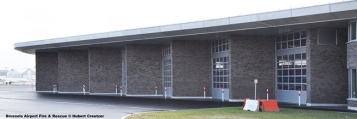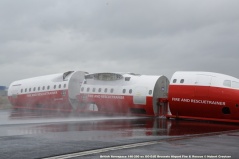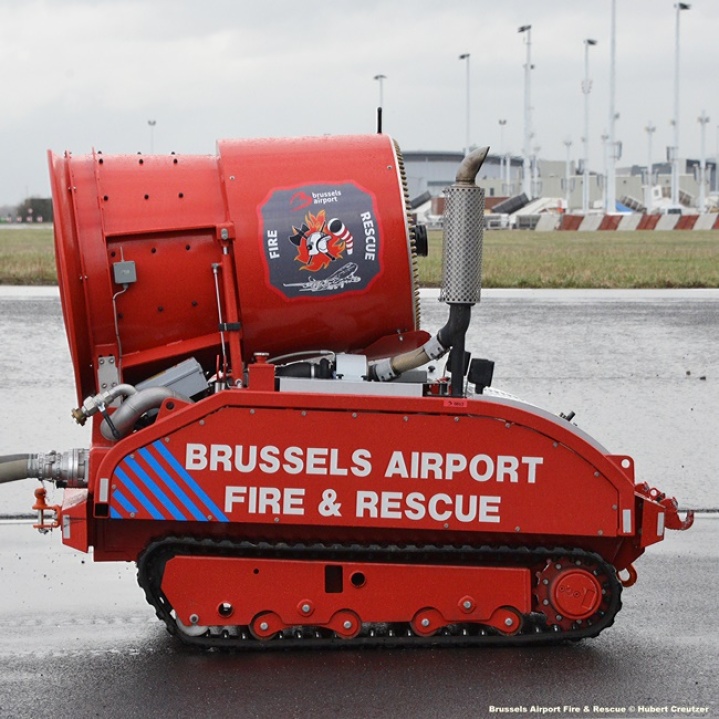Translation in english available at the bottom.
Dos nuevos cuarteles de bomberos fueron construidos en el aeropuerto de Bruselas.
Los dos nuevos cuarteles están ubicados al este y al oeste del aeropuerto y reemplazan los antiguos cuarteles ubicados en la zona del aeropuerto así como al lado de la terminal.
La nueva ubicación, ubicada entre las pistas 25R y 25L, a los lados del sitio del aeropuerto, permite llegar incluso más rápido durante una intervención.
«Nuestros nuevos cuarteles se encuentran entre los mejores de Europa, fueron desarrollados para operar de manera aún más efectiva en situaciones de emergencia y están equipados con las últimas tecnologías. Proporcionan a nuestros bomberos toda la comodidad que necesitan para reaccionar rápidamente y correctamente a las intervenciones. Se ha prestado especial atención a la durabilidad de estos edificios para que tengan un alto rendimiento energético y sean muy eficientes en el uso del agua” Comentó Arnaud Feist, CEO de Brussels Airport Company.
Al diseñar la estación de bomberos, fue necesario tener en cuenta el buen progreso de las intervenciones de los bomberos del aeropuerto.
En caso de un incidente en la pista, los bomberos deben poder estar en el sitio dentro de 3 minutos. Y si hay un problema en la terminal o en otra zona del aeropuerto, tienen 5 minutos para intervenir.
Gracias a este nuevo proyecto, nuestros bomberos pueden intervenir dentro de los 30 segundos posteriores a la activación de la alarma. Un tiempo muy corto que responde al tiempo de reacción requerido por la reglamentación del aire.
Ambos cuarteles tienen un garaje central lo suficientemente grande como para almacenar todos los vehículos que necesitan estar listos para la intervención, como por ejemplo sistemas de protección contra accidentes y robots-bomberos. Los vehículos están estacionados en el garaje de manera que ninguno de ellos tenga que maniobrar o retroceder en él.
Además del garaje, el cuartel cuenta también con varias salas técnicas, salas de reuniones equipadas con las últimas tecnologías, oficinas, salones y salas de relajación.
Los cuarteles oeste y este son muy energéticamente económicos. Estos edificios reciben la electricidad que necesitan de unos 800 paneles solares instalados en su techo.
La iluminación es completamente LED, y los sistemas de calefacción y refrigeración de la estación de bomberos están asegurados gracias a las bombas de calor. Los calentadores de agua solares se utilizan para calentar el agua sanitaria.
Colectores de agua fueron instalados sobre los techos para poder recuperar y reutilizar el agua de lluvia para la extinción de incendios o para fines sanitarios. Entre ellos 2, los colectores de los dos cuarteles pueden recoger hasta 230.000 litros de agua. Estos sistemas permiten llenar los 8 crashtenders casi dos veces.
Largas ventanas fueron instaladas en el cuartel oeste para limitar el aire acondicionado en verano. Los dos cuarteles también se construyeron de concreto para facilitar el reciclaje de infraestructuras.
En la presentación de estas instalaciones, pudimos presenciar un ejercicio de extinción de incendios en un avión, así como el uso de un robot durante incendios en lugares más difíciles o peligrosos para los bomberos tales como los túneles o los edificios (hangares).
La brigada de bomberos del aeropuerto de Bruselas cuenta con 145 hombres y mujeres divididos en 5 grupos operativos.
Descubrimos más en detalles dos nuevos vehículos de intervención.
Primero, los camiones Crashtenders 04 y 05 tienen un estanque de agua de 12,500L a 16,500L, un estanque de Foam de 1,000 a 3,000L y una bomba de 7,000 a 11,600L por minuto.
Estos vehículos son nuevos y entregados desde aproximadamente 6 meses. La vida operacional con BAC es de 15 a 20 años.
El otro vehículo es el robot de intervención que se desplaza a una velocidad de 6 km / h y está equipado con una bomba de 2400L / min. La distancia de intervención es de 60m.
En cuanto a la cantidad de intervenciones, es de aproximadamente 900 por año, de las cuales el 42% están en relación con los aviones. El resto se refiere a intervenciones técnicas (13%), logística (7%) e incidentes con sustancias peligrosas (5%).
Algunas figuras más acercan los dos edificios:
Cuartel oeste
– edificio de 4.632 m².
– Número de paneles solares: 750
– Pisos: 2
– capacidad de vehículos estacionados: +/- 25
– Colectores de agua: capacidad de 170.000 litros para re-utilización de agua de lluvia.
Cuartel este
– edificio de 1.413 m².
– Número de paneles solares: 45
– Pisos: 2
– Capacidad de Vehículos estacionados: +/- 5.
– Colectores de agua: capacidad de 60 000 litros para la re-utilización del agua de lluvia.
Estos cuarteles siéndose ubicados en medio de las pistas, debajo del despegue de los aviones, les reservo una pequeña galería de aviones que pasaron sobre nuestras cabezas durante la visita de estos cuarteles.
Agradecemos al servicio de prensa del Aeropuerto de Bruselas por organizar la visita a estas instalaciones, así como a todos los bomberos en el aeropuerto por permitirnos ver una simulación de una de sus intervenciones.
Fuente: Comunicado de prensa de BAC.
Hubert Creutzer
The new fire stations at the Brussels airport.
Two new fire stations were built at the Brussels airport.
The two new buildings are located east and west of the airport zone and replace the old installations located in the airport area as well as next to the terminal.
The new stations, located between runway 25R and 25L, on the sides of the airport site, allows to reach even faster during an intervention.
«Our new stations are among the best in Europe; were developed to operate even more effectively in emergency situations and are equipped with the latest technologies, providing our firefighters with all the comfort they need to react quickly and correctly to interventions. Particular attention has been paid to the sustainability of these buildings so that they have a high-energy efficiency and are very efficient in the use of water «commented Arnaud Feist, CEO of Brussels Airport Company.
When designing the fire station, it was necessary to take into account the good progress of the interventions of the airport firefighters.
In the event of an incident on the runway, firefighters should be able to be on site within 3 minutes. Moreover, if there is a problem in the terminal or in another area of the airport, they have 5 minutes to intervene.
Thanks to this new project, our firefighters can intervene within 30 seconds after the activation of the alarm. A very short time that responds to the reaction time required by the Air Regulation.
Both buildings have a central garage large enough to store all vehicles that need to be ready for intervention, such as accident protection systems and fire-fighting robots.
The vehicles are parked in the garage in a way that neither of them has to manoeuvre or retreat in it.
In addition to the garage, the building also has several technical rooms, meeting rooms equipped with the latest technologies, offices, lounges and relaxation rooms.
The west and east stations are very energy efficient. These buildings receive the electricity they need from about 800 solar panels installed on their roof.
The lighting is completely LED, and the heating and cooling systems of the fire station are insured thanks to the heat pumps. Solar water heaters are used to heat sanitary water.
Water collectors were installed on roofs in order to recover and reuse rainwater for fire extinguishing or for sanitary purposes.
Between them two, the collectors of the two stations can collect up to 230,000 litres of water. These systems allow filling the eight crashtenders almost twice.
Long windows were installed in the west station to limit the air conditioning in summer. The two buildings were also constructed of concrete to facilitate the recycling of infrastructures.
In the presentation of these facilities, we were able to witness an exercise to extinguish fires in an airplane, as well as the use of a robot during fires in more difficult or dangerous places for firefighters such as tunnels or hangars.
The fire brigade of the Brussels airport has 145 men and women divided into 5 operational groups
We discovered more in detail two new intervention vehicles.
First, the Crashtenders 04 and 05 have a water tank of 12,500L to 16,500L, a Foam pond of 1,000 to 3,000L and a pump of 7,000 to 11,600L per minute.
These vehicles are new and delivered from approximately 6 months. Operational life with BAC is 15 to 20 years.
The other vehicle is the intervention robot that moves at a speed of 6 km / h and is equipped with a pump of 2400L / min. The intervention distance is 60m.
In terms of the number of interventions, it is approximately 900 per year, of which 42% are related to aircraft. The rest refers to technical interventions (13%), logistics (7%) and incidents with dangerous substances (5%).
Some more figures bring the two buildings closer:
West station
– 4,632 m² building.
– Number of solar panels: 750
– Floors: 2
– capacity of parked vehicles: +/- 25
– Water collectors: capacity of 170,000 litres of reused rainwater.
East Station
– 1,413 m² building.
– Number of solar panels: 45
– Floors: 2
– Capacity of parked vehicles: +/- 5.
– Water collectors: capacity of 60,000 litres for the reuse of rainwater.
These stations being located in the middle of the runways, under the take-off of the aircrafts, I reserve you a small gallery of aircraft that passed over our heads during the visit of these buildings.
We thank the press service of the Brussels Airport for organizing the visit to these facilities, as well as all the firefighters at the airport for allowing us to see one of their interventions.
Source: LAC press release.
Hubert Creutzer






























































